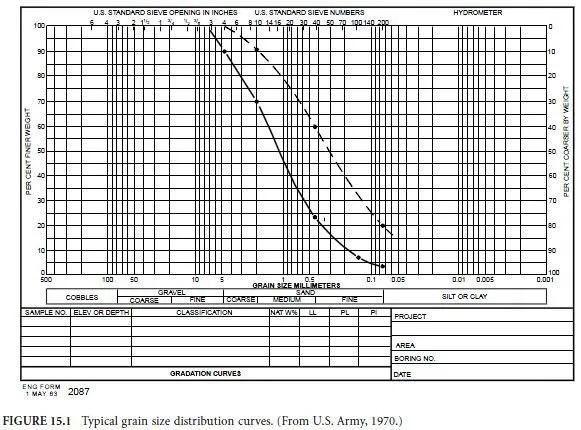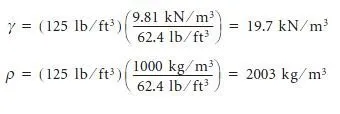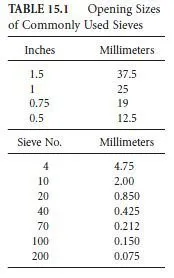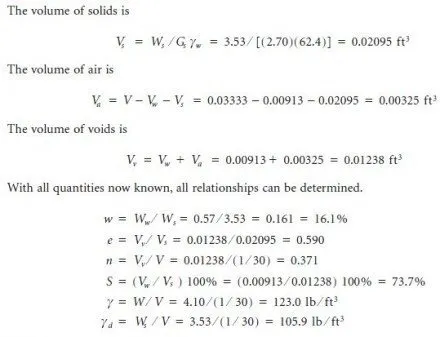Example 15.1
Classify the soil shown by the solid curve in Fig. 15.1. Assume the soil is nonplastic. The following data are obtained:
Percent passing No. 4 sieve: 90%
Percent passing No. 10 sieve: 70%
Percent passing No. 40 sieve: 23%
Percent passing No. 200 sieve: 4%
D60 size: 1.50 mm
D30 size: 0.61 mm
D10 size: 0.18 mm
To classify the soil in the Unified Soil Classification System, the percent passing the No. 200 sieve is first checked. As only 4% passes the No. 200 sieve, the soil is coarse grained. The coarse fraction makes up 96% of the soil, with 10% being gravel (larger than the No. 4 sieve) and 86% being sand (the difference between the Nos. 4 and 200 sieves). As there is more sand than gravel, the soil is a sand and the first letter is S.
As less than 5% passes the No. 200 sieve, the sand is clean (SP or SW). The coefficient of uniformity is (1.5)/(0.18) = 8.33. The coefficient of curvature is 0.612/(1.5)(0.18) = 1.38. As the coefficient of uniformity is greater than 6.0 and the coefficient of curvature is between 1 and 3, the soil meets both of the criteria for SW and is so classified.
In the AASHTO system the soil is 30% gravel, 47% coarse sand, 19% fine sand, and 4% silt-clay.
Proceeding from left to right on the classification chart, the soil cannot be classified as A-1-a because the soil has 70% passing the No. 10 and that classification permits a maximum of 50%. The soil meets the classification criteria for A-1-b and is so classified.

Example 15.2
Classify the soil represented by the dashed curve in Fig. 15.1. The liquid limit and plastic limit are found
to be 30 and 20, respectively. The following data are obtained:
Percent passing No. 4 sieve: 100%
Percent passing No. 10 sieve: 91%
Percent passing No. 40 sieve: 60%
Percent passing No. 200 sieve: 20%
D60 size: 0.41 mm
D30 size: 0.12 mm
D10 size: <0.074 mm
Liquid limit: 30
Plastic limit: 20
First the soil is classified by the Unified Soil Classification System. As only 20% of the soil is smaller than a No. 200 sieve, the soil is coarse grained. All of the coarse fraction is smaller than the No. 4 sieve, so the soil is sand (first letter S).
As the percentage passing the No. 200 sieve is greater than 12%, the gradation characteristics are not considered, and the Atterberg limits are examined to determine whether the sand is a clayey sand or silty sand. The plasticity index is calculated as 30 20 = 10, and the coordinates LL = 30, PI = 10 are entered on the plasticity chart. As this plots in the CL region, the fines are clay and the soil is a clayey sand SC.
Next the soil is classified according to the AASHTO system. Following the classification table from left to right, group A-1 is eliminated due to too much material passing the No. 40 sieve, and group A-3 is eliminated due to too much material passing the No. 200 sieve. The soil passes the criteria for A-2-4 and is so classified. The group index is calculated as:
Group index = (F 35)[0.2 + 0.005(LL 40)] + 0.01(F 15)(PI 10)
where F = 20, the percent passing the No. 200 sieve. Thus:
Group index = (20 35)[0.2 + 0.005(30 40)] + 0.01(20 15)(10 10)
= (15 )[0.2 + ( 0.05)] + 0
= 15(0.15)
= 2.25
This is rounded to the nearest whole number, 2, and the soil classification is reported as A-2-4(2).
Example 15.3
A fine-grained soil has the following properties:
Percent passing No. 200 sieve: 65%
Liquid limit: 60
Plastic limit: 28
First the soil is classified according to the unified system. As more than 50% of the sample passes the
No. 200 sieve, the soil is fine grained and the plasticity chart is used. The plasticity index is 60 28 = 32.
The coordinates (60, 32) plot in the CH region, so the soil is a high-plasticity clay (CH).
To classify the soil in the AASHTO system, one notes that more than 35% passes the No. 200 sieve,
so the soil is silt-clay. Entering the coordinates (60, 32) on the AASHTO plasticity chart, the classification
is A-7-6. The group index is calculated as follows:
Group index = (F 35)[0.2 + 0.005(LL 40)] + 0.01(F 15)(PI 10)
= (65 35)[0.2 + 0.005(60 40)] + 0.01(65 15)(32 10)
= 30[0.2 + 0.1] + 0.01(50)(22)
= 9.0 + 11.0
= 20
The complete classification is A-7-6(20), which indicates a poor quality soil for highway construction.





